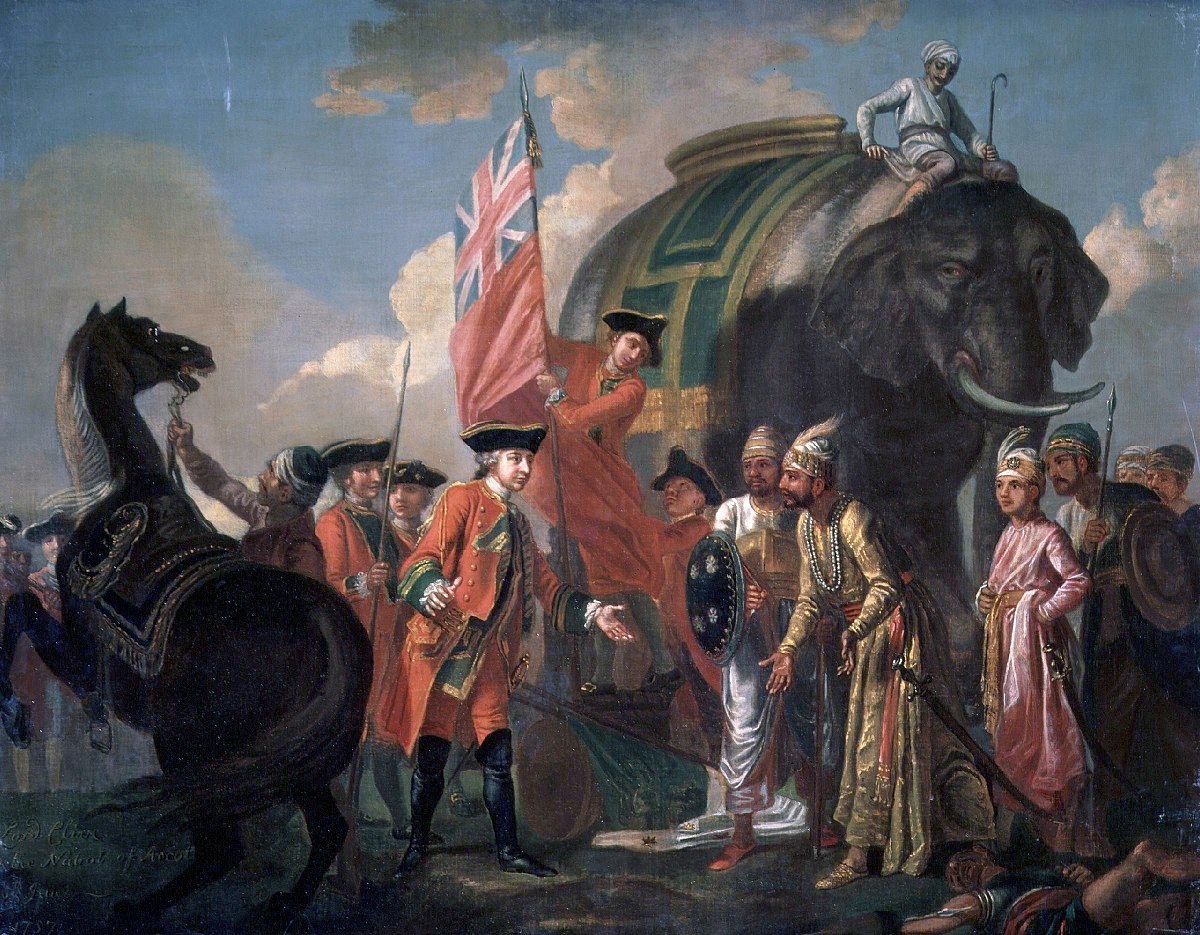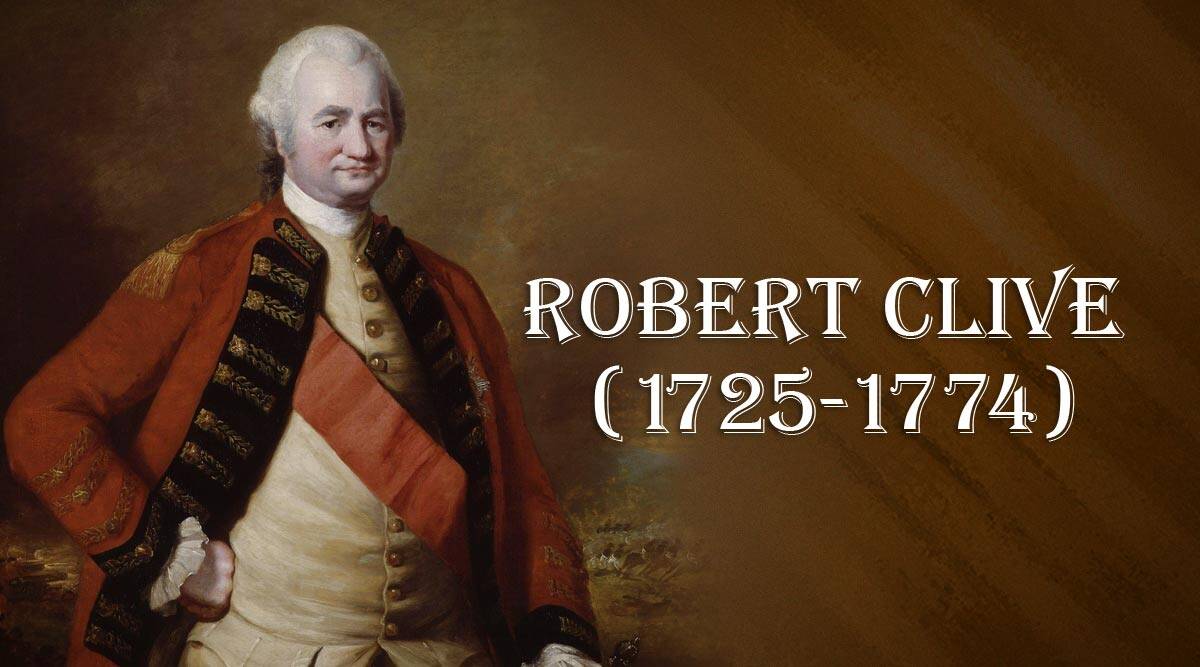The victory of the East India Company in the Battle of Plassey marks the establishment of British Rule in Bengal. However the British were already enjoying the many monopolistic businesses as well as local administration rights which was no less than the British rule for the Indian traders. But victory in this decisive battle made the East India Company of one the strongest contenders who can replace the Mughals from the Central power of Hindustan and can establish British Rule in the Indian subcontinent.
Battle of Plassey was fought on 23rd June 1757, between the forces of Nawab Siraj-ud-Daula & the English forces led by Robert Clive. The victory of the British forces in this battle helped in the establishment of the company’s political influence in Bengal, Bihar, and Orissa. This victory paved the way for the emergence of British rule.
Battle of Plassey: The Begining of British Rule

The larger circumstances leading to the Battle of Plassey can be traced to the emergence of Siraj-ud-Daula as Nawab of Bengal in April 1756. Siraj-Ud-Daula was a comparatively weak & inexperienced ruler. He was not good as was his predecessors Ali Wardi Khan. The rise of Siraj-Ud-Daula was challenged by many others in Bengal. Among these, the group of Ghasiti Begum (wisdom of Ali Wardi Khan) & Harsan Shaukat Jung was strongest. This is what paved the way for Englishmen to enter this hidden battle. They were sniffing their permanent establishment of British rule in the Bengal through this internal battle for the throne.
The British were very loyal to the motherland, the area where Indians were miles behind them. This may be because of the political stability in England that provided sufficient time for generations of love and respect toward their motherland. On the other hand, there was no single-point of stability in the Indian subcontinent since the invasion of Muslim leaders and Mughals.
These conspirators were sheltered by the English Company & because this relation of Siraj-Ud-Daula & company were not on good terms at the very beginning. The issue of misuse of “Dastak” had further complicated relations. Dastak was a free permit/pass issued by the president of the English factory for company goods. The company got a return to issue Dastak through the Farman of Faruksiyar issued in 1717.
The company was supposed to use Dastak to only sold goods, but Dastak was misused to cover the private trade of company officials. At the time Dastak was sold to Indian merchants. The immediate issue that resulted in conflict between Nawab & the English Company was an additional fortification of Calcutta. Taking advantage of the weakness of Siraj-Ud-Daula, the company carried out additional fortification of Calcutta & placed guns on its walls. Nawab strongly opposed this because he took it as disrespect to its authority.
The company was asked to remove additional fortification & not give shelter to rebels but the companies’ reply was evasive. This angered the Nawab, so his forces marched and attacked Calcutta in June 1756 & captured it. This skirmish resulted in the loss of several Englishman’s life. Meanwhile, Nawab returned to his capital Murshidabad after planting Manikchand as an administrator in Calcutta. When news of the loss of Calcutta reached Madras Admiral Watson, then Colonel Robert Clive was sent with about 2500 Europeans & Indian soldiers to retrieve Calcutta & seek compensation from the Nawab.
Calcutta was retrieved by the company by bribing Manikchand. By using conspirators of Bengal, Nawab was terrified to sign the treaty of Alinagar 1757 through which he agrees to pay compensation for losses suffered by the company. Robert Clive could sense an opportunity to place the Company’s route on the throne of Bengal by joining hands with conspirators. Mir Jafar (Nawab’s uncle & former commissioner of Chief), Manikchand (officer), Raidurlab (officer) & Jugal Seth (chief Banker of Manikchand) were part of this conspiracy.
Treaty of Alinagar: Treaty of Alinagar, (Feb. 9, 1757), pact concluded in India by the British agent Robert Clive after he recovered Calcutta on January 2, 1757, from the nawab of Bengal, Siraj-ud-Daulah. The treaty was the prelude to the British seizure of Bengal. The Nawab had seized Calcutta in June 1756, but he was eager to secure his rear from the threat of attack by the Afghans, who had just taken and sacked Delhi.
The treaty restored Calcutta to the East India Company with its privileges and permitted the fortification of the town and the coining of money. The treaty was named after the short-lived title given to Calcutta by Siraj after his capture of the city. Siraj-ud-Daulah was defeated and deposed by Clive later the same year.
Clive’s decision to replace Siraj-Ud-Daula through battle was not supported by Admiral Watson’s commander of company forces. Clive forged Watson’s signature to carry the company’s troops to the battlefield. Nawab Siraj-Ud-Daula could be easily defeated & Mir Jafar could be placed on the throne of Bengal.
Significance of the Battle of Plassey in rising of British Rule
The outcome of this battle established direct British rule in Bengal, and a teddy bear nawab on the throne. The military significance of the Battle of Plassey was negligible because its outcome was not decided by the strength of armor superiority of leadership. The faith of battle was decided by the treasury of conspirators. Much before 1st shot was fired in the Battle of Plassey the outcome was decided by Robert Clive in favor of the British. Robert Clive had already bribed several important Nobel and trustworthy Nawab. These trustworthy and loyal cheaters had already joined hands with Robert Clive and helped in the establishment of British rule in Bengal.
Battle of Plassey was not a great battle but it was a great betrayal because only a small part of Nawab’s troop led by Mir Madan & Mohan Lal fought honestly. Mir Madan got killed by a stray shot & Mohan Lal had to run away from the battle. Mir Jafar was commanding 50,000 soldiers out of 62,000 totals. He kept on standing outside the battlefield. After the death of Mir Madan & the retreating of Mohan Lal, Mir Jafar persuaded Nawab to go back to the capital. Now conspirators joined hands with Clive to bring battle to end.
Only 65 members lost by the English side & casualty on the Indian side 5,000. On a hand ford battle, this number could have much higher. By honest fight by the commander of Nawab could have undoubtedly produced a different result so it commented that the Battle of Plassey was nothing but a backstab by the trustworthy cheaters of Nawabs who had given preferences to the money over their motherland. Ultimately, they are the culprits who showed the way to the Englishmen to establish British Rule in Bengal and the Indian subcontinent.
The immediate political significance of this battle was also not much for Bengal because the battle was just the replacement of one Nawab by others. Immediately after the Battle of Plassey the company was not political power in Bengal but gradually the company’s political influence in Bengal continues to increase within a couple of years Nawab was completely dependent on the mercy of the company. The company had started to take an all-important decision that why Bengal emerged as a sponsored state after the Battle of Plassey.
In 1760, Mir Jafar was replaced by Mir Qasim when he tried to come out of companies’ control. The economic significance of the Battle of Plassey was far greater having succeeded in placing their favorite. On the throne of Bengal, it was quite clear that the company would no more face any competition in trade & commerce of Bengal. English Company established its monopoly over the trade of Bengal by using Nawab.
The company got the amount of Rupaiya of 1 crore from Mir Jafar along with Jamindari of 24 pargana. These resources were used by the company to finance its struggle against the French in the South. These resources of Bengal turned the table against the French & contributed to the success of the company in the Anglo-French rivalry. The victory of English forces in the Battle of Plassey paved the way for the British rule and commencement of exploitation of resources of Bengal Company used its political influence to exploit Indian partition & craftsman, i.e. its commented Bengal emerged as a plundered state after Battle of Plassey.
Frequently Asked Questions (FAQs): Establishment of British Rule in Bengal
Question: Which battle victory is marked as the beginning of British rule in the Indian Subcontinent?
Answer: The victory in the Battle of Plassey (1757) of the British was marked as the beginning of British rule in the Indian subcontinent.
Question: When was the Battle of Plassey was fought?
Answer: The Battle of Plassey was fought on the 23rd June 1757 between Nawab of Bengal and the British East India Company. This battle was won by the East India Company and this battle victory is marked as the establishment of British rule in the Indian subcontinent.

